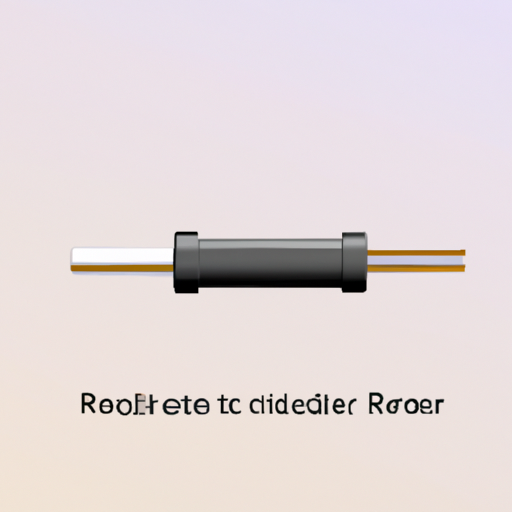What Kind of Product is the Resistor RT54?

I. Introduction
In the world of electronics, resistors play a crucial role in the functionality of circuits. A resistor is a passive electrical component that limits or regulates the flow of electrical current in a circuit. They are essential for controlling voltage and current levels, ensuring that electronic devices operate safely and efficiently. Among the myriad of resistor models available, the RT54 resistor stands out due to its unique specifications and applications. This blog post will delve into the characteristics, applications, advantages, and comparisons of the RT54 resistor, providing a comprehensive understanding of its significance in modern electronics.
II. Overview of Resistors
A. Function of Resistors in Electrical Circuits
Resistors serve several key functions in electrical circuits:
1. **Current Limiting**: Resistors are used to limit the amount of current flowing through a circuit, protecting sensitive components from damage due to excessive current.
2. **Voltage Division**: They can divide voltage in a circuit, allowing for different voltage levels to be supplied to various components.
3. **Signal Conditioning**: Resistors are integral in shaping and conditioning signals, ensuring that they are at the appropriate levels for processing.
B. Types of Resistors
Resistors come in various types, each serving different purposes:
1. **Fixed Resistors**: These resistors have a constant resistance value and are commonly used in most electronic applications.
2. **Variable Resistors**: Also known as potentiometers, these allow for adjustable resistance, making them useful in applications like volume controls.
3. **Specialty Resistors**: These include thermistors, photoresistors, and others designed for specific applications, such as temperature sensing or light detection.
III. Specifications of the RT54 Resistor
A. Physical Characteristics
1. **Size and Form Factor**: The RT54 resistor is designed with a compact form factor, making it suitable for various applications where space is a constraint.
2. **Material Composition**: Typically, the RT54 is made from high-quality materials that ensure durability and reliability, often featuring a ceramic or metal film construction.
B. Electrical Specifications
1. **Resistance Value Range**: The RT54 resistor is available in a range of resistance values, allowing it to be used in diverse applications.
2. **Power Rating**: This resistor model is designed to handle specific power ratings, ensuring it can operate effectively without overheating.
3. **Tolerance Levels**: The RT54 offers various tolerance levels, which indicate how much the actual resistance can vary from the stated value, providing flexibility for different circuit requirements.
C. Temperature Coefficient
The temperature coefficient of the RT54 resistor indicates how its resistance changes with temperature. A low temperature coefficient is desirable as it ensures stable performance across varying environmental conditions.
IV. Applications of the RT54 Resistor
A. Common Uses in Electronic Devices
The RT54 resistor finds applications in various electronic devices, including:
1. **Consumer Electronics**: It is commonly used in devices like televisions, radios, and smartphones, where precise current and voltage control is essential.
2. **Industrial Applications**: In industrial settings, the RT54 is utilized in machinery and control systems, ensuring reliable operation under demanding conditions.
3. **Automotive Electronics**: The automotive industry employs the RT54 in various electronic systems, including engine control units and infotainment systems, where reliability is paramount.
B. Role in Circuit Design
1. **Signal Processing**: The RT54 is crucial in signal processing circuits, helping to filter and amplify signals for better performance.
2. **Power Management**: It plays a significant role in power management circuits, ensuring that devices operate within safe voltage and current limits.
3. **Protection Circuits**: The RT54 is often used in protection circuits to safeguard sensitive components from voltage spikes and surges.
V. Advantages of Using the RT54 Resistor
A. Reliability and Durability
One of the standout features of the RT54 resistor is its reliability. Built with high-quality materials, it can withstand harsh conditions, making it a preferred choice for critical applications.
B. Performance Characteristics
The RT54 offers excellent performance characteristics, including low noise and stable resistance values, which are essential for high-fidelity electronic applications.
C. Cost-Effectiveness
Despite its high performance, the RT54 resistor is cost-effective, making it accessible for both manufacturers and hobbyists. Its affordability does not compromise quality, making it a popular choice in various projects.
VI. Comparison with Other Resistor Models
A. Similarities and Differences with Other Resistors
While the RT54 shares similarities with other fixed resistors, it distinguishes itself through its specific electrical specifications and applications. Compared to other models, the RT54 may offer better performance in certain scenarios, such as in high-frequency applications.
B. Situations Where RT54 is Preferred Over Others
The RT54 is often preferred in applications requiring high reliability and precision. For instance, in automotive electronics, where failure can lead to significant safety issues, the RT54’s robust design and specifications make it an ideal choice.
VII. Conclusion
In summary, the RT54 resistor is a vital component in the realm of electronics, offering a blend of reliability, performance, and cost-effectiveness. Its specifications make it suitable for a wide range of applications, from consumer electronics to industrial machinery. As technology continues to evolve, the demand for high-quality resistors like the RT54 will only increase, paving the way for advancements in electronic design and functionality. Understanding the role of resistors, particularly models like the RT54, is essential for anyone involved in electronics, whether as a professional or a hobbyist.
VIII. References
For those interested in further exploring the world of resistors and the RT54 model, the following resources are recommended:
1. "The Art of Electronics" by Paul Horowitz and Winfield Hill
2. "Electronic Components: A Complete Reference for Project Builders" by Mark J. Smith
3. Manufacturer datasheets for the RT54 resistor and similar models
4. Online electronics forums and communities for practical insights and applications
By understanding the significance of the RT54 resistor, readers can appreciate its role in shaping the future of electronic technology.
What Kind of Product is the Resistor RT54?

I. Introduction
In the world of electronics, resistors play a crucial role in the functionality of circuits. A resistor is a passive electrical component that limits or regulates the flow of electrical current in a circuit. They are essential for controlling voltage and current levels, ensuring that electronic devices operate safely and efficiently. Among the myriad of resistor models available, the RT54 resistor stands out due to its unique specifications and applications. This blog post will delve into the characteristics, applications, advantages, and comparisons of the RT54 resistor, providing a comprehensive understanding of its significance in modern electronics.
II. Overview of Resistors
A. Function of Resistors in Electrical Circuits
Resistors serve several key functions in electrical circuits:
1. **Current Limiting**: Resistors are used to limit the amount of current flowing through a circuit, protecting sensitive components from damage due to excessive current.
2. **Voltage Division**: They can divide voltage in a circuit, allowing for different voltage levels to be supplied to various components.
3. **Signal Conditioning**: Resistors are integral in shaping and conditioning signals, ensuring that they are at the appropriate levels for processing.
B. Types of Resistors
Resistors come in various types, each serving different purposes:
1. **Fixed Resistors**: These resistors have a constant resistance value and are commonly used in most electronic applications.
2. **Variable Resistors**: Also known as potentiometers, these allow for adjustable resistance, making them useful in applications like volume controls.
3. **Specialty Resistors**: These include thermistors, photoresistors, and others designed for specific applications, such as temperature sensing or light detection.
III. Specifications of the RT54 Resistor
A. Physical Characteristics
1. **Size and Form Factor**: The RT54 resistor is designed with a compact form factor, making it suitable for various applications where space is a constraint.
2. **Material Composition**: Typically, the RT54 is made from high-quality materials that ensure durability and reliability, often featuring a ceramic or metal film construction.
B. Electrical Specifications
1. **Resistance Value Range**: The RT54 resistor is available in a range of resistance values, allowing it to be used in diverse applications.
2. **Power Rating**: This resistor model is designed to handle specific power ratings, ensuring it can operate effectively without overheating.
3. **Tolerance Levels**: The RT54 offers various tolerance levels, which indicate how much the actual resistance can vary from the stated value, providing flexibility for different circuit requirements.
C. Temperature Coefficient
The temperature coefficient of the RT54 resistor indicates how its resistance changes with temperature. A low temperature coefficient is desirable as it ensures stable performance across varying environmental conditions.
IV. Applications of the RT54 Resistor
A. Common Uses in Electronic Devices
The RT54 resistor finds applications in various electronic devices, including:
1. **Consumer Electronics**: It is commonly used in devices like televisions, radios, and smartphones, where precise current and voltage control is essential.
2. **Industrial Applications**: In industrial settings, the RT54 is utilized in machinery and control systems, ensuring reliable operation under demanding conditions.
3. **Automotive Electronics**: The automotive industry employs the RT54 in various electronic systems, including engine control units and infotainment systems, where reliability is paramount.
B. Role in Circuit Design
1. **Signal Processing**: The RT54 is crucial in signal processing circuits, helping to filter and amplify signals for better performance.
2. **Power Management**: It plays a significant role in power management circuits, ensuring that devices operate within safe voltage and current limits.
3. **Protection Circuits**: The RT54 is often used in protection circuits to safeguard sensitive components from voltage spikes and surges.
V. Advantages of Using the RT54 Resistor
A. Reliability and Durability
One of the standout features of the RT54 resistor is its reliability. Built with high-quality materials, it can withstand harsh conditions, making it a preferred choice for critical applications.
B. Performance Characteristics
The RT54 offers excellent performance characteristics, including low noise and stable resistance values, which are essential for high-fidelity electronic applications.
C. Cost-Effectiveness
Despite its high performance, the RT54 resistor is cost-effective, making it accessible for both manufacturers and hobbyists. Its affordability does not compromise quality, making it a popular choice in various projects.
VI. Comparison with Other Resistor Models
A. Similarities and Differences with Other Resistors
While the RT54 shares similarities with other fixed resistors, it distinguishes itself through its specific electrical specifications and applications. Compared to other models, the RT54 may offer better performance in certain scenarios, such as in high-frequency applications.
B. Situations Where RT54 is Preferred Over Others
The RT54 is often preferred in applications requiring high reliability and precision. For instance, in automotive electronics, where failure can lead to significant safety issues, the RT54’s robust design and specifications make it an ideal choice.
VII. Conclusion
In summary, the RT54 resistor is a vital component in the realm of electronics, offering a blend of reliability, performance, and cost-effectiveness. Its specifications make it suitable for a wide range of applications, from consumer electronics to industrial machinery. As technology continues to evolve, the demand for high-quality resistors like the RT54 will only increase, paving the way for advancements in electronic design and functionality. Understanding the role of resistors, particularly models like the RT54, is essential for anyone involved in electronics, whether as a professional or a hobbyist.
VIII. References
For those interested in further exploring the world of resistors and the RT54 model, the following resources are recommended:
1. "The Art of Electronics" by Paul Horowitz and Winfield Hill
2. "Electronic Components: A Complete Reference for Project Builders" by Mark J. Smith
3. Manufacturer datasheets for the RT54 resistor and similar models
4. Online electronics forums and communities for practical insights and applications
By understanding the significance of the RT54 resistor, readers can appreciate its role in shaping the future of electronic technology.













